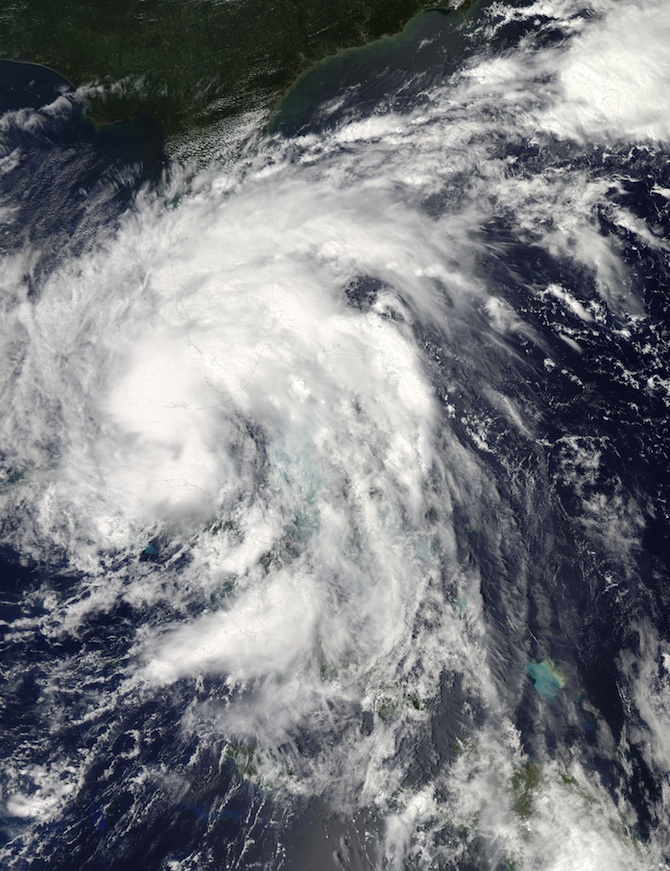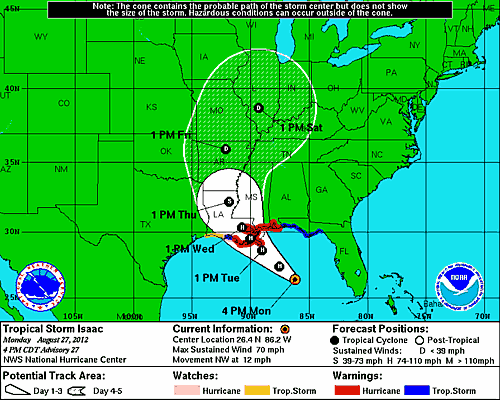SUMMARY
This is AI generated summarization, which may have errors. For context, always refer to the full article.

NEW ORLEANS, Louisiana, United States (UPDATED) – The people of New Orleans on Monday, August 27 (Tuesday, August 28 in Manila) prepared themselves for yet another hurricane — seven years after the fabled city of jazz was swamped by Hurricane Katrina, which left 1,800 dead.
President Barack Obama, no doubt mindful of the bungled handling of that tragedy by his predecessor George W. Bush, declared a state of emergency in Louisiana, allowing federal funds and aid to flow to local authorities.
The president also convened a briefing with officials including Federal Emergency Management Agency administrator (FEMA) Craig Fugate, hours before Tropical Storm Isaac was expected to become a Category One hurricane.
Katrina left behind a devastating sprawl of destruction and death when it hit New Orleans on August 29, 2005, and a halting emergency response from the Bush administration was a black mark on his second term in office.
The National Hurricane Center (NHC) said in its 0300 GMT bulletin that Isaac was about 255 miles (410 kilometers) south-southeast of Biloxi, Mississippi and packing maximum sustained winds of 70 miles per hour.
A hurricane warning was issued earlier for New Orleans and nearby areas as Isaac churned toward the northern Gulf of Mexico coast, with the storm likely to reach hurricane force late Monday or early Tuesday, and then make landfall.
Alabama governor Robert Bentley has ordered mandatory evacuations in Mobile and Baldwin, counties that sit on the Gulf Coast.
Louisiana Governor Bobby Jindal, who has recommended voluntary evacuations within the hurricane watch area, urged people to prepare for the worst.
“If you are in low lying areas and are thinking about evacuating, today is the day to do that,” he said Monday.

“If you plan on hunkering down at home, today is the day to get supplies. I strongly encourage people not to wait,” added Jindal, who stayed away from the weather-affected Republican National Convention in Tampa, Florida.
Those heeding the call included Tammy Edmondson, who looked anxious as she picked through the grocery shelves at a Target store with her daughter and a friend in tow.
Edmonson left town ahead of Katrina and it was a month before she could go home.
“We had a lot of damage — we’re still fixing some of it,” she said.
FEMA said its National Response Coordination Center had been activated and would handle eventual requests for aid from affected states.
The emergency management agency has also deployed four disaster response teams to Gulf states and has moved other resources to pre-positioned command locations closer to the potential storm impact areas.
Isaac has been moving slowly so far and was swirling in the Gulf of Mexico about 190 miles (305 kilometers) southeast of the mouth of the Mississippi River, but the storm is beginning to gather pace, the Miami-based NHC said.
“Isaac is expected to become a hurricane tonight or early Tuesday and continue to strengthen until landfall occurs along the northern Gulf Coast,” it warned.
Mississippi activated 1,500 National Guard troops on Monday and Louisiana issued orders to approximately 4,100 soldiers and airmen in preparation of the storm making landfall. Florida called up only a few dozen service personnel.
Louisiana, Mississippi and Alabama issued emergency warnings on Sunday, 24 hours after Isaac forced the main program of the Republican convention to be postponed by one day.
The NHC also warned that Isaac could spawn “isolated tornadoes” over central and northwestern Florida on Monday.
Katrina was the third deadliest US hurricane on record, destroying homes and instigating a human crisis in New Orleans, a city famed for music, an easygoing atmosphere and Creole cuisine.
Seven years ago, 1.4 million residents and visitors were ordered to evacuate New Orleans as Hurricane Katrina approached, but many could not or would not and were left stranded.
A lack of preparation forced residents to take shelter in attics, and then break through their roofs to escape rising water, but countless numbers died while the nation’s leaders appeared to be unwilling to step in and help them.
Isaac brought rain and choppy seas to the Florida Keys after battering Haiti, where 19 people died, and Cuba over the weekend.
In Tampa, the Republican convention began with a whimper as the bad weather reduced the opening of Mitt Romney’s coronation as the party’s presidential candidate to a muted, symbolic session of less than two minutes.
Party officials have said primetime speaking slots on Tuesday, Wednesday and Thursday, including speeches by Romney, his wife Ann and running-mate Paul Ryan, remain unchanged. – Mira Oberman, Agence France-Presse
Add a comment
How does this make you feel?
There are no comments yet. Add your comment to start the conversation.